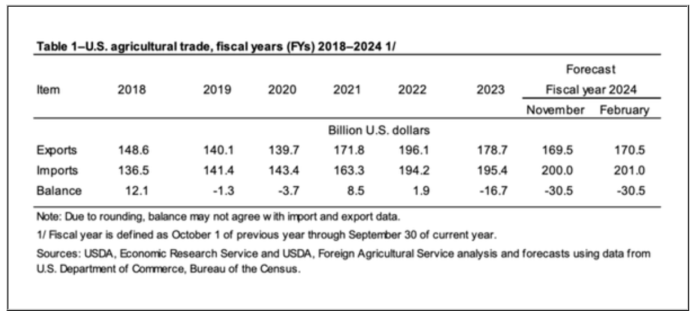By Ryan Hanrahan, University of Illinois’ FarmDoc project
The United States Department of Agriculture this week raised its fiscal year 2024 agricultural export and import forecasts by $1 billion each, holding steady its estimate of a $30.5 billion U.S. ag trade deficit in 2024.
Fiscal year 2024 exports are now forecast at $170.5 billion, while imports are estimated at $201.0 billion. An ag trade deficit of $30.5 billion would be the largest trade deficit ever, according to reporting from FERN’s Ag Insider in December, and “would be nearly double the current record of $16.7 billion for fiscal 2023.”
Exports
The USDA Economic Research Service reported that “exports of livestock and dairy, as well as grains and feeds, lead the (export) increase, which more than offset reductions in oilseeds and products. As a group, livestock, poultry, and dairy exports are forecast up $1.4 billion to $37.7 billion.”
Beef exports are projected to be $700 million higher than November’s forecast, pork exports are forecast $600 million higher and dairy exports are forecast $500 million higher.
“Overall grain and feed exports are projected at $38.2 billion, up $700 million from November, as higher exports of corn, sorghum, rice, and feeds and fodders more than offset moderately lower wheat exports,” the USDA reported. “Oilseed and product exports are forecast at $36.2 billion, a $1.0 billion reduction from the previous quarter, almost entirely due to lower soybean volume and unit values resulting from increased South American competition. ”
Imports
The USDA Economic Research Service reported that the increase in ag imports “is predominantly driven by higher beef imports, which are raised $1.2 billion to $10.1 billion. Tight U.S. supplies coupled with firm demand are expected to stimulate increased shipments of processing beef at higher unit values.”
Pork imports are forecast $100 million higher than November’s forecast, live cattle imports are also forecast $100 million higher and dairy imports are forecast $200 million lower than November’s forecast.
“Grains and feed imports are adjusted up $500 million from the November Outlook to $22.4 billion largely on continued growth expectations of processed grain products,” the USDA reported. “Generally, imports of animal feeds have declined marginally, with the largest exception being pet food from Canada. Food grain imports are expected to be up in FY 2024 driven mostly by rice imports.”
“The February FY 2024 imports forecast is 2.9 percent above FY 2023 imports, which remains below the average annual import growth rate of 7 percent over the last 20 years,” the USDA reported.
Ag Trade Deficit Concerns
A growing number of congressional lawmakers have expressed concern in recent months over the forecasted ag trade deficit, and on Feb. 26, a group of 22 legislators sent a letter to Agriculture Secretary Tom Vilsack and United States Trade Representative Katherine Tai “to express our concerns regarding the rising agricultural trade deficit and loss of opportunities for U.S. international trade capabilities that will impact the ability of American producers to remain competitive in the global market.”
“We remain concerned that the recent farm trade deficit trend may be attributable in some regard to the proactive trade policies of our economic competitors,” the letter said. “This could unfortunately leave the U.S. behind in global trade pacts. As such, our nation must be vigorous in efforts to pursue additional market access and expand exports through new trade agreements.”
However, the agricultural trade deficit is expected to “narrow in the near term as exchange rates improve and trading partners gain economic strength, said the Agriculture Department in its 10-year agricultural baseline,” according to FERN’s Ag Insider. “The deficit would shrink to $14.7 billion in 2028 and hold steady after that.”
 |
|---|







